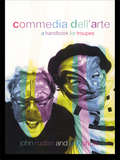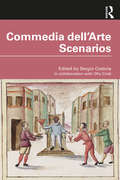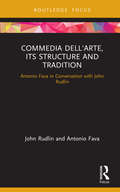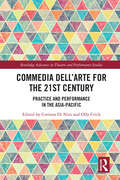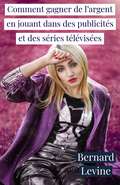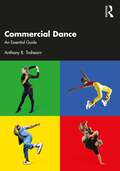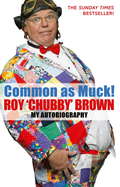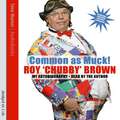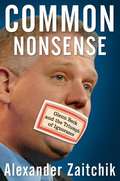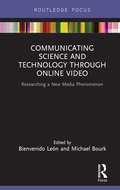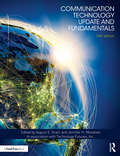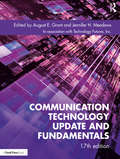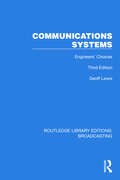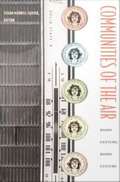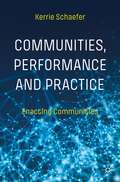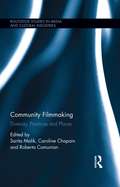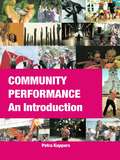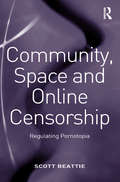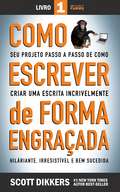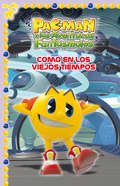- Table View
- List View
Commedia Dell'Arte: A Handbook for Troupes
by John Rudlin Oliver CrickA companion to John Rudlin's best-selling Commedia dell'Arte: A Handbook for Actors, this book covers both the history and professional practice of commedia dell'arte companies from 1568 to the present day. Indispensable for both the beginner and the professional, it contains historical and contemporary company case histories, details on company organisation, and tips on practical stagecraft. Essential for students and practitioners, this book enables the reader to understand how successful commedia dell'arte companies function, and how we can learn from past and current practice to create a lively and dynamic form of theatre. Includes tips on: * writing a scenario * mask-making * building a stage * designing a backdrop * costume * music. _
Commedia Dell'arte An Actor's Handbook: An Actor's Handbook
by John RudlinThere has been an enormous revival of interest in Commedia dell'arte. And it remians a central part of many drama school courses. In Commedia dell'arte in the Twentieth Century John Rublin first examines the orgins of this vital theatrical form and charts its recent revival through the work of companies like Tag, Theatre de Complicite and the influential methods of Jacques Lecoq. The second part of the book provides a unique practical guide for would-be practitioners: demonstrating how to approach the roles of Zanni, Arlecchion, Brighella, Pantalone, Dottore, and the Lovers in terms of movement, mask-work and voice. As well as offering a range of lazzi or comic business, improvisation exercises, sample monologues, and dialogues. No other book so clearly outlines the specific culture of Commedia or provides such a practical guide to its techniques. This immensely timely and useful handbook will be an essential purchase for all actors, students, and teachers.
Commedia dell'Arte Scenarios
by Olly Crick Sergio CostolaCommedia dell'Arte Scenarios gathers together a collection of scenarios from some of the most important Commedia dell'Arte manuscripts, many of which have never been published in English before. Each script is accompanied by an editorial commentary that sets out its historical context and the backstory of its composition and dramaturgical strategies, as well as scene summaries, and character and properties lists. These supplementary materials not only create a comprehensive picture of each script’s performance methods but also offer a blueprint for readers looking to perform the scenarios as part of their own study or professional practice. This collection offers scholars, performers and students a wealth of original performance texts that brig to life one of the most foundational performance genres in world theatre.
Commedia dell'Arte, its Structure and Tradition: Antonio Fava in Conversation with John Rudlin
by John Rudlin Antonio FavaCommedia dell'Arte, its Structure and Tradition chronicles a series of discussions between two renowned experts in commedia dell'arte – master practitioners Antonio Fava and John Rudlin. These discussions were recorded during three recent visits by Fava to Rudlin’s rural retreat in south west France. They take in all of commedia dell'arte's most striking and enduring elements – its masks, its scripts and scenarios, and most outstandingly, its cast of characters. Fava explores the role of each stock Commedia character and their subsequent incarnations in popular culture, as well as their roots in prominent figures of their time. The lively and wide-ranging conversations also take in methods of staging commedia dell'arte for contemporary audiences, the evolution of its gestures, and the collective nature of its theatre-making. This is an essential book for any student or practitioner of commedia dell'arte – provocative, expansive wisdom from the modern world's foremost exponent of the craft.
Commedia dell’Arte for the 21st Century: Practice and Performance in the Asia-Pacific (Routledge Advances in Theatre & Performance Studies)
by Olly Crick Corinna Di NiroThis book discusses the evolution of Commedia dell’Arte in the Asia-Pacific where through the process of reinvention and recreation it has emerged as a variety of hybrids and praxes, all in some ways faithful to the recreated European genre. The contributors in this collection chart their own training in the field and document their strategies for engaging with this form of theatre. In doing so, this book examines the current thoughts, ideas, and perceptions of Commedia – a long-standing theatre genre, originating in a European-based collision between neo-classical drama and oral tradition. The contributing artists, directors, teachers, scholars and theatre-makers give insight into working styles, performance ideas, craft techniques and ways to engage an audience for whom Commedia is not part of their day-to-day culture. The volume presents case studies by current practitioners, some who have trained under known Commedia ‘masters’ (e.g. Lecoq, Boso, Mazzone-Clementi and Fava) and have returned to their country of origin where they have developed their performance and teaching praxis, and others (e.g. travelling from Europe to Japan, Thailand, Singapore and China) who have discovered access points to share or teach Commedia in places where it was previously not known. This book will be of great interest to students and scholars in Performing arts, Italian studies, and History as well as practitioners in Commedia dell’Arte.
Comment gagner de l’argent en jouant dans des publicités et des séries télévisées
by Bernard LevineAvez-vous déjà souhaité obtenir un emploi en apparaissant dans des publicités télévisées? ....comme les publicités des téléphones portables Samsung ou Nokia, les publicités de McDonald's ou Coca Cola. Aimeriez-vous jouer un rôle dans une série télévisée ou un feuilleton? Aucune expérience n'est nécessaire. Pour vous, voici venue l'occasion de réaliser vos rêves. C'est tellement amusant et l'argent que vous y gagnerez le vaudra bien!
Commercial Dance: An Essential Guide
by Anthony R. TrahearnThis is an exploration of the vital and rapidly evolving world of Commercial Dance, tracing the evolution and merging of Hip-Hop, Club and Jazz dance styles from the music videos of the early 1980s, to today's huge influence on pop music and dance in a multi-media culture. Chapters including ‘Iconic Moments’ and ‘Main Movers’ contextualise and analyse culturally significant works and choreographers. With direct contributions from an international array of industry leading dancers, choreographers and creatives - including JaQuel Knight (Beyonce’s choreographer), Rich + Tone Talauega (Madonna & Michael Jackson collaborators), Rebbi Rosie (Rihanna’s dancer), Dean Lee (Janet Jackson’s choreographer) and Kiel Tutin (BLACKPINK’s choreographer) - this book shines a light on the creatives in the Commercial Dance industry who have made significant impacts, not just on the world of dance but on popular culture itself. Chapters discussing dance history, copyright law, inclusivity and dance class culture as well as additional contributions from dance scholars enable this book to give credence to Commercial Dance as a legitimate academic area of study. This is a complete and comprehensive textbook for all dance students at any level of study on college, university or conservatory courses.
Common As Muck!: The Autobiography of Roy 'Chubby' Brown
by Roy Chubby BrownBy the time he was nineteen, Royston Vasey had married, divorced, fathered two children, spent two years in Britain's toughest Borstal, served three prison stretches and been stabbed while in the Merchant Navy. He thought his only career choice would be a life of crime. Fifteen years later, he was one of Britain's most successful comics, playing live to half a million fans a year as Roy 'Chubby' Brown. COMMON AS MUCK! tells an incredible story of hardships, heartbreak and, ultimately, success. From an impoverished childhood with his abusive father, to his brand of comedy too rude for television and his determined fight against throat cancer, COMMON AS MUCK! is a frank telling of a remarkable life, laced with Roy's irrepressible humour.
Common As Muck!: The Autobiography of Roy 'Chubby' Brown
by Roy Chubby BrownAbandoned by his mother when he was just nine years old, by the time Royston Vasey was nineteen he had been married, divorced, had two children, spent two years in Borstal and several months in prison, and had been shot at in the Merchant Navy. By the time he was thirty-five, he was one of Britain's most successful comics, playing live to half a million fans a year as Roy 'Chubby' Brown. In Common as Muck he tells his incredible story. Frank, funny and - perhaps unexpectedly - often moving, it is a tale of a man battling to escape his background and become a star. From his impossibly deprived childhood to his controversial comic persona to his more recent battle against throat cancer, Roy 'Chubby' Brown's life is as remarkable and fascinating as the man himself.
Common Nonsense: Glenn Beck and the Triumph of Ignorance
by Alexander ZaitchikWho is this guy and why are people listening? Forget Rush Limbaugh, Bill O'Reilly, and Sean Hannity--Glenn Beck is the right's new media darling and the unofficial leader of the conservative grassroots. Lampooned by the left and lionized by the far right, his bluster-and-tears brand of political commentary has commandeered attention on both sides of the aisle. Glenn Beck has emerged over the last decade as a unique and bizarre conservative icon for the new century. He fantasizes aloud about killing his political opponents and encourages his listeners to embrace a cynical paranoia that slides easily into a fantasyland filled with enemies that do not exist, and solutions that are incoherent, at best. Since the election of Barack Obama, Beck's bombastic, conspiratorial, and often viciously personal approach to political combat has made him one of the most controversial figures in the history of American broadcasting. In Common Nonsense, investigative reporter Alexander Zaitchik explores Beck's strange brew of ratings lust, boundless ego, conspiratorial hard-right politics, and gimmicky morning-radio entertainment chops. Separates the facts from the fiction, following Beck from his troubled childhood to his recent rise to the top of the conservative media heap. Zaitchik's recent three-part series in Salon caused so much buzz, Beck felt the need to attack it on his show. Based on Zaitchik's interviews with former Beck coworkers and review of countless Beck writings and television and radio shows. Examines Beck's high-profile obsessions (Acorn and Van Jones) as well as his lesser-known influences (obscure Mormon radicals like Cleon Skousen.) Zaitchik's writing has appeared in the New Republic, the Nation, Salon, Wired, the New York Times, and AlternetBeck, a perverse and high-impact media spectacle, has emerged as a leader in a conservative protest movement that raises troubling questions about the health of American democracy.
Communicating Marginalized Masculinities: Identity Politics in TV, Film, and New Media (Routledge Studies in Rhetoric and Communication #11)
by Ronald L. Jackson II Jamie E. MoshinFor years, research concerning masculinities has explored the way that men have dominated, exploited, and dismantled societies, asking how we might make sense of marginalized masculinities in the context of male privilege. This volume asks not only how terms such as men and masculinity are socially defined and culturally instantiated, but also how the media has constructed notions of masculinity that have kept minority masculinities on the margins. Essays explore marginalized masculinities as communicated through film, television, and new media, visiting representations and marginalized identity politics while also discussing the dangers and pitfalls of a media pedagogy that has taught audiences to ignore, sidestep, and stereotype marginalized group realities. While dominant portrayals of masculine versus feminine characters pervade numerous television and film examples, this collection examines heterosexual and queer, military and civilian, as well as Black, Japanese, Indian, White, and Latino masculinities, offering a variance in masculinities and confronting male privilege as represented on screen, appealing to a range of disciplines and a wide scope of readers.
Communicating Science and Technology Through Online Video: Researching a New Media Phenomenon (Routledge Focus on Communication Studies)
by Bienvenido León Michael BourkOnline video’s unique capacity to reach large audiences makes it a powerful tool to communicate science and technology to the general public. The outcome of the international research project "Videonline," this book provides a unique insight into the key elements of online science videos, such as narrative trends, production characteristics, and issues of scientific rigor. If offers various methodological approaches: a literature review, content analysis, and interviews and surveys of expert practitioners to provide information on how to maintain standards of rigour and technical quality in video production.
Communication Technology Update and Fundamentals: 16th Edition
by August E. Grant Jennifer H. MeadowsFor three decades, Communication Technology Update and Fundamentals has set the standard as the single best resource for students and professionals looking to brush up on how communication technologies have developed, grown, and converged, as well as what’s in store for the future. The secret to the longevity is simple—every two years, the book is completely rewritten to ensure that it contains the latest developments in mass media, computers, consumer electronics, networking, and telephony. Plus, the book includes the Fundamentals: the first five chapters explain the communication technology ecosystem, the history, structure, and regulations. The chapters are written by experts who provide snapshots of the state of each individual field. Together, these updates provide a broad overview of these industries, as well as the role communication technologies play in our everyday lives. In addition to substantial updates to each chapter, the 16th edition includes: First-ever chapters on Virtual/Augmented Reality and eSports. Updated user data in every chapter. Overview of industry structure, including recent and proposed mergers and acquisitions Suggestions on how to get a job working with the technologies discussed. The companion website, www.tfi.com/ctu, offers updated information on the technologies covered in this text, as well as links to other resources.
Communication Technology Update and Fundamentals: 17th Edition
by Inc. August E. Grant Jennifer H. Meadows Technology FuturesCommunication Technology Update and Fundamentals, now in its 17th edition, has set the standard as the single best resource for students and professionals looking to brush up on how communication technologies have developed, grown, and converged, as well as what’s in store for the future. The book covers the fundamentals of communication technology in five chapters that explain the communication technology ecosystem, its history, theories, structure, and regulations. Each chapter is written by experts who each provide a snapshot of an individual field. The book also dives into the latest developments in electronic mass media, computers, consumer electronics, networking, and telephony. Together, these updates provide a broad overview of these industries and examine the role communication technologies play in our everyday lives. In addition to substantial updates to each chapter, the 17th edition includes the first-ever chapter on Artificial Intelligence; updated user data in every chapter; an overview of industry structure, including recent and proposed mergers and acquisitions; and sidebars exploring sustainability and relevance of each technology to Gen Z. Communication Technology Update and Fundamentals continues to be the industry-leading resource for both students and professionals seeking to understand how communication technologies have developed and where they are headed.
Communications Systems: Engineers' Choices (Routledge Library Editions: Broadcasting #18)
by Geoff LewisCommunications Systems (1999) examines various communications systems using satellites, and includes much information on coding and modulation systems such as MOBIC, digital SNG systems, mobile phones, MPEG, MPEG4 capabilities and Hypermedia, the Grand Alliance TV systems, MUSE and how it is used in Japan, the European and North American Digital Video Broadcasting Systems, MMDS and Digital Audio Broadcasting. It explores the rapid convergence occurring between satellite and terrestrial services. It provides a solid base of principles, including mathematics where necessary, to explain the developments which have taken place within these industries.
Communities of the Air: Radio Century, Radio Culture
by Susan Merrill SquierA pioneering analysis of radio as both a cultural and material production, Communities of the Air explores radio's powerful role in shaping Anglo-American culture and society since the early twentieth century. Scholars and radio writers, producers, and critics look at the many ways radio generates multiple communities over the air--from elite to popular, dominant to resistant, canonical to transgressive. The contributors approach radio not only in its own right, but also as a set of practices--both technological and social--illuminating broader issues such as race relations, gender politics, and the construction of regional and national identities. Drawing on the perspectives of literary and cultural studies, science studies and feminist theory, radio history, and the new field of radio studies, these essays consider the development of radio as technology: how it was modeled on the telephone, early conflicts between for-profit and public uses of radio, and amateur radio (HAMS), local programming, and low-power radio. Some pieces discuss how radio gives voice to different cultural groups, focusing on the BBC and poetry programming in the West Indies, black radio, the history of alternative radio since the 1970s, and science and contemporary arts programming. Others look at radio's influence on gender (and gender's influence on radio) through examinations of Queen Elizabeth's broadcasts, Gracie Allen's comedy, and programming geared toward women. Together the contributors demonstrate how attention to the variety of ways radio is used and understood reveals the dynamic emergence and transformation of communities within the larger society. Contributors. Laurence A. Breiner, Bruce B. Campbell, Mary Desjardins, Lauren M. E. Goodlad, Nina Hunteman, Leah Lowe, Adrienne Munich, Kathleen Newman, Martin Spinelli, Susan Merrill Squier, Donald Ulin, Mark Williams, Steve Wurzler
Communities, Performance and Practice: Enacting Communities
by Kerrie SchaeferThis book examines how a predominantly negative view of community has presented a challenge to critical analysis of community performance practice. The concept of community as a form of class-based solidarity has been hollowed out by postmodernism’s questioning of grand narratives and poststructuralism’s celebration of difference. Alongside the critique of a notion of community has been a critical re-signification of community, following the thinking of philosopher Jean-Luc Nancy who conceives of community not as common being but as being-in-common. The concept of community as being-in-common generates questions that have been taken up by feminist geographers, J.K. Gibson-Graham, in theorising a post-capitalist approach to community-based development. These questions and approaches guide the analyses in researched case studies of community performance practice. The book revises theoretical debates that have defined the field of community theatre and performance. It asks how the critical re-signification of community aligns with these debates and, at the same time, opens new modes of critical analysis of community theatre and performance practice.
Community Filmmaking: Diversity, Practices and Places (Routledge Studies in Media and Cultural Industries)
by Sarita Malik Caroline Chapain Roberta ComunianThis book examines the role of community filmmaking in society and its connection with issues of cultural diversity, innovation, policy and practice in various places. Deploying a range of examples from Europe, North America, Australia and Hong Kong, the chapters show that film emerging from outside the mainstream film industries and within community contexts can lead to innovation in terms of both content and processes and a better representation of the cultural diversity of a range of communities and places. The book aims to situate the community filmmaker as the central node in the complex network of relationships between diverse communities, funding bodies, policy and the film industries.
Community Performance: An Introduction
by Petra KuppersCommunity Performance: An Introduction is a comprehensive and accessible practice-based primer for students and practitioners of community arts, dance and theatre. It is both a classroom-friendly textbook and a handbook for the practitioner, perfectly answering the needs of a field where teaching is orientated around practice. Offering a toolkit for students interested in running community arts groups, this book includes: international case-studies and first person stories by practitioners and participants sample exercises, both practical and reflective study questions excerpts of illustrative material from theorists and practitioners. This book can be used as a standalone text or together with its companion volume, The Community Performance Reader, to provide an excellent introduction to the field of community arts practice. Petra Kuppers has drawn on her vast personal experience and a wealth of inspiring case studies to create a book that will engage and help to develop the reflective community arts practitioner.
Community Radio in South Asia: Reclaiming the Airwaves
by Vinod Pavarala Kanchan K. MalikThis book explores the state of community radio, a significant independent media movement that began about two decades ago, in different parts of South Asia. The volume outlines the socioeconomic and historical contexts for understanding the evolution and functioning of community radio in an increasingly globalised media environment. It provides a ring-side view of how various countries in South Asia have formulated policies that enabled the emergence of this third sector of broadcasting (public and private being the other two) through radio, rendering the media ecology in the region more pluralistic and diverse. The chapters in the volume, interspersed by practitioner perspectives, discuss a range of key issues related to community radio: radio policies, NGOisation of community radio, spectrum management and democratisation of technology, disasters/emergencies, gender issues, sustainability, and conflicts. One of the first of its kind, this volume will appeal to scholars and researchers of community media and independent media studies, cultural studies, as well as sociology and social anthropology, and South Asian studies.
Community Theatre: Global Perspectives
by Eugene van ErvenCommunity theatre is an important device for communities to collectively share stories, to participate in political dialogue, and to break down the increasing exclusion of marginalised groups of citizens. It is practised all over the world by growing numbers of people. Published at the same time as a video of the same name, this is a unique record of these theatre groups in action. Based on van Erven's own travels and experiences working with community theatre groups in six very different countries, this is the first study of their work and the methodological traditions which have developed around the world.
Community, Space and Online Censorship: Regulating Pornotopia
by Scott BeattieInternet censorship is a controversial topic - while the media periodically sounds alarms at the dangers of online life, the uncontrollable nature of the internet makes any kind of pervasive regulatory control impossible. This book compares the Australian solution, a set of laws which have been criticized as being both draconian and ineffectual, to major regulatory systems in the UK and US and understanding what drives them. The 'impossibility' of internet regulation opens deeper issues - what do we mean by regulation and how do we judge the certainty and effectiveness of law? These questions lead to an exploration of the theories of legal geography which provide tools to understand and evaluate regulatory practices. The book will be a valuable guide for academics, students and policy makers working in media and censorship law, those from a civil liberties interest and people interested in internet theory generally.
Como Dar uma Festa como um Profissional
by Gabriel Martimiano Pires Richard G Lowe JrAs festas dão um monte de trabalho e podem ser caras. Encontrar um lugar para realizar seu evento, levar as pessoas a participar, fazendo-a funcionar sem problemas, organizar e terminar pode exigir uma imensa quantidade de esforço. No entanto é um pouco de diversão sair com um grupo de amigos no ambiente organizado de uma festa. Há algo de especial em socializar, sair, conversar, entreter-se, comer, beber e aproveitar o tempo juntos. Leia este livro e saiba: * Por que fazer uma festa? * As decisões que você precisa tomar * Aluguel de espaço * Contratação de um DJ * Como você lida com permissão de bebidas alcoólicas? * Considerações especiais sobre crianças em festas * Como fazer os convites * Como você mantém o controle durante a festa * Coisas para saber sobre como organizar e terminar uma festa
Como Escrever de Forma Engraçada: Seu Projeto Passo A Passo De Como Criar Uma Escrita Incrivelmente Hiláriante (Como Escrever de Forma Engraçada #1)
by Scott DikkersO Manual Definitivo de Redação de Piadas Aprenda a escrever comédias e piadas com uma fórmula simples que você pode usar agora para criar suas próprias piadas. Veja por que os revisores da Amazon chamam o livro Como Escrever de Forma Engraçada de: "Um dos melhores livros sobre escrita humorística". O autor Scott Dikkers mostrará como escrever piadas. Ele é um escritor, fundador do site de humor The Onion, autor de humor nº 1 do New York Times e de best-sellers nº 1 da Amazon e cartunista de sucesso. Scott criou e lidera o centro de treinamento "Writing with The Onion" na famosa Second City, em Chicago. Seus alunos foram contratados para trabalhos de comédia na TV e ganharam dezenas de prêmios Emmy. Scott Dikkers é consultado por grandes empresas de entretenimento como NBC, Comedy Central e Pixar. Este guia fácil de seguir apresenta um sistema claro e uma fórmula simples de como escrever uma piada que trará grandes risadas de tirar leite do nariz. De forma confiável, você vai aprender... • As três maneiras seguras de gerar textos engraçados • Os 11 "Filtros Engraçados" e como usá-los para escrever piadas • O segredo para se livrar do bloqueio de escritor - permanentemente • E muitas outras dicas, truques e técnicas de escrita humorística Se você já se perguntou como pode começar a escrever e contar piadas para seus amigos e familiares, ou talvez, como adicionar humor à sua escrita, piadas em um discurso ou como adicionar humor à sua apresentação, este livro explica de forma simples a fórmula utilizada pelos profissionais na sua escrita. Como Escrever de Forma Engraçada é para você, se você deseja encontrar um emprego de escritor de comédia ou apenas quer aprender a contar uma piada.
Como en los viejos tiempos (Pac-Man. Primeras lecturas #4)
by Varios AutoresPac tiene un nuevo reto: ¡dejar de comer a todas horas! Pero le va costar mucho esfuerzo y más de una sorpresa. Además, deberá cumplir una nueva misión: las cámaras espía del Infierno han localizado el almacén de cuerpos de fantasmas, y Betrayus pretende recuperarlos para invadir el Pac Mundo. Con la ayuda de Espiral, Cilindra y Sir Cunferencia no hay fantasma que se escape del apetito de Pac.
